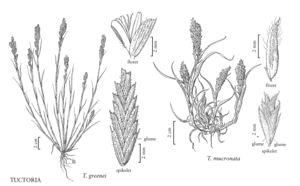Difference between revisions of "Tuctoria mucronata"
FNA>Volume Importer |
imported>Volume Importer |
||
| (8 intermediate revisions by 2 users not shown) | |||
| Line 4: | Line 4: | ||
|publications= | |publications= | ||
|common_names=Prickly spiralgrass | |common_names=Prickly spiralgrass | ||
| + | |special_status={{Treatment/ID/Special_status | ||
| + | |code=E | ||
| + | |label=Endemic | ||
| + | }} | ||
|basionyms= | |basionyms= | ||
|synonyms= | |synonyms= | ||
| Line 17: | Line 21: | ||
-->{{Treatment/Body | -->{{Treatment/Body | ||
|distribution=Calif. | |distribution=Calif. | ||
| − | |discussion=<p>Tuctoria mucronata is known from only two locations in Solano County, California; both locations are at elevations below 10 m.</p> | + | |discussion=<p><i>Tuctoria mucronata</i> is known from only two locations in Solano County, California; both locations are at elevations below 10 m.</p> |
|tables= | |tables= | ||
|references= | |references= | ||
| Line 26: | Line 30: | ||
-->{{#Taxon: | -->{{#Taxon: | ||
name=Tuctoria mucronata | name=Tuctoria mucronata | ||
| − | |||
|authority=(Crampton) Reeder | |authority=(Crampton) Reeder | ||
|rank=species | |rank=species | ||
| Line 37: | Line 40: | ||
|publication title= | |publication title= | ||
|publication year= | |publication year= | ||
| − | |special status= | + | |special status=Endemic |
| − | |source xml=https:// | + | |source xml=https://bitbucket.org/aafc-mbb/fna-data-curation/src/200273ad09963decb8fc72550212de541d86569d/coarse_grained_fna_xml/V25/V25_949.xml |
|subfamily=Poaceae subfam. Chloridoideae | |subfamily=Poaceae subfam. Chloridoideae | ||
|tribe=Poaceae tribe Orcuttieae | |tribe=Poaceae tribe Orcuttieae | ||
Latest revision as of 17:59, 11 May 2021
Culms to 12 cm, ascending, often decumbent or geniculate at the base; nodes usually concealed by the leaves. Blades 2-4 cm, involute, usually curved outward, tapering to a fine point. Spikes 1.5-6 cm, more or less included in the upper sheaths at maturity, congested throughout; internodes 1-2 mm. Spikelets with 5-10 florets. Glumes subequal (or the lower slightly shorter than the upper), 4-7 mm, mucronate, sometimes with 1 or 2 short lateral teeth; lemmas 5-7 mm, prominently 11-15-veined, apices erose or with a few minute teeth, central vein extending into a prominent mucro as much as 1 mm long; paleas slightly shorter than the lemmas; anthers about 3 mm, yellow, becoming pinkish in drying; lodicules about 0.5 mm, fused to the paleas. Caryopses about 3 mm, laterally compressed, broadly oblong, smooth. 2n = 40.
Discussion
Tuctoria mucronata is known from only two locations in Solano County, California; both locations are at elevations below 10 m.
Selected References
None.
